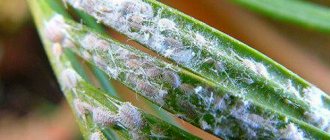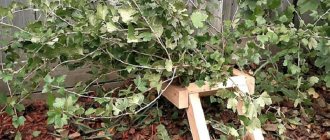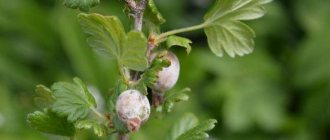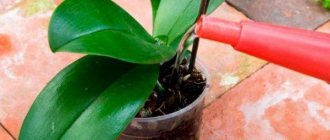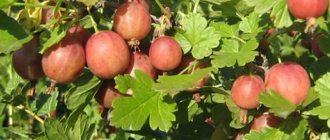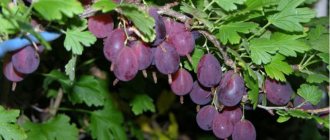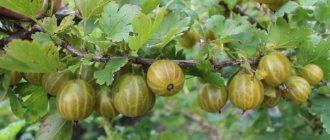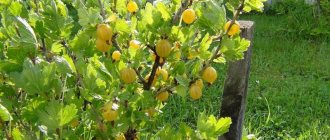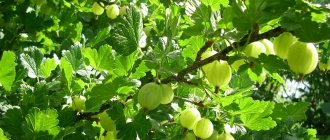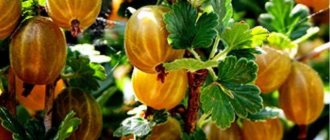- American powdery mildew on gooseberries: control methods and prevention
- White bloom on gooseberries: distinctive features of powdery mildew
- Why does powdery mildew occur every year?
- Gooseberry varieties resistant to powdery mildew
- Prevention of powdery mildew on gooseberries
- Treating gooseberries with copper sulfate or milk solution
- Treatment of gooseberry bushes with ash infusion
- White bloom on gooseberries: combating powdery mildew on gooseberries
- Use of chemicals
- Use of biochemical drugs
- Traditional methods of protecting gooseberries from powdery mildew
- Video: treating gooseberries for powdery mildew
American powdery mildew on gooseberries: control methods and prevention
Protecting plants from various diseases takes up the lion's share of summer residents' time in the summer. And this struggle does not always end with a positive result for plants. One of the most harmful diseases affecting gooseberries is considered to be American powdery mildew, or gooseberry spheroteca. In this article we will tell you whether the disease can be prevented, and what to do if a white coating does appear on the gooseberries.
White bloom on gooseberries.
How to process gooseberries?
Also check out these articles
- Description of the Rinda cabbage variety, planting and care in open ground
- Spunbond and its types
- Strawberry variety Selva
- Grafting pruner
White plaque on gooseberries can only be combated comprehensively; a one-time spraying will not help. The first thing to do is remove all damaged areas (leaves, branches, berries) and burn them. In the fall, pruning is done to the healthy part of the branches, leaves and weeds are constantly removed under the bushes. The soil is loosened and dug up from time to time. All this will help contain the fungus and prevent it from spreading.
Remedies for powdery mildew
If powdery mildew develops frequently, you need to regularly spray the crop with specialized products.
- The first time it is done before flowering begins.
- The second - in the period after the bush has faded.
- The third spraying is done 3 weeks before harvest.
As a remedy for powdery mildew, you can use Topaz, Cumulus or Vectra. These products have proven themselves and do not affect the quality of the berries.
White bloom on gooseberries: distinctive features of powdery mildew
The first manifestations of damage to gooseberry bushes by spheroteka coincide with the beginning of bud bloom. A cobwebby white coating appears on the upper side of the young leaf blade and on the tops of the shoots, which gradually grows, thickens and takes on a felt-like appearance, speckled with black dots. This is a mycelium with spores.
As it grows, it moves to the entire above-ground part of the plant. The mycelium releases viable spores that scatter under the influence of wind and raindrops. It is this first infection that is the most harmful; it affects leaves and young shoots and ovaries.
If nothing is done, the diseased plant stops its development, the berries fall off while still growing and ripening, the shoots become bent, the bush gradually takes on the appearance of being sprinkled with lime mortar and dies. At the same time, ideal conditions are created on the site for further infection of not only gooseberries, but also other fruit-bearing shrubs.
The first manifestations of damage to gooseberry bushes by spheroteka coincide with the beginning of bud break, so it is important to carry out preventive spraying of the bushes at this time.
White plaque
This disease is popularly called white plaque. Also, white plaque is a symptom of one of the most common diseases of gooseberries, strawberries, cucumbers and other cultivated garden plants - powdery mildew or spheroteca.
It is divided into 2 types: American and European. Both types are similar in appearance, but differ only in the type of fungus that causes the disease.
Signs
Symptoms appear either at the beginning of summer or by spring. This usually happens as soon as the bush blooms. The young vegetative parts of the gooseberry (most often on the inside) are covered with a predominantly white coating, loose in structure.
In the early stages of the disease, plaque is easily erased from the surface of the leaves, this is due to the fact that many novice gardeners may confuse the symptom of infection with ordinary dirt. Over time, fungal colonies spread to the ovaries of the plant and the berries themselves.
Gradually, the plaque becomes denser and in later stages acquires a dark shade of brown.
One of the consequences of this disease is a slowdown and subsequent cessation of the growth and development of gooseberry shoots, their deformation.
The leaves of an infected plant dry out and fall off. The maximum damage caused by powdery mildew disease occurs in the harvest: gooseberry berries stop growing, a dense layer of plaque forms on their surface, they burst and begin to crack.
If timely treatment is not started, infected bushes may die in two or three seasons, and the fungal pores will certainly spread to other shrubs located next to the infected bush.
This disease also persists on fallen, dead leaves and branches; despite fairly low temperatures, the disease can attack the plant again
Treatment
Once a powdery mildew disease is detected, it will be necessary to continue the fight against spheroteca throughout the entire season. It is imperative to remember about preventive methods.
At the moment, several methods of treating gooseberries have been identified, with varying effectiveness:
- The diseased parts of the gooseberry, as well as the berries, must be removed from the plant and taken out of your area, after which they are completely destroyed.
- By the beginning of spring, it is necessary to treat gooseberry bushes with hot water, since high temperatures completely affect fungal diseases such as white plaque.
- By the time the first ovaries form, it is recommended to resort to the use of fungicides. The most common is Bordeaux liquid (copper sulfate + milk) or soda ash in solution (50 g per ten liters of ordinary water). To enhance the reaction and maximize interaction with the bush, it is recommended to add about 50 g of laundry soap to the mixture. It is recommended to spray with various chemicals before twelve o'clock in the afternoon so that the sprayed leaves of the plant are not burned by the sun.
- If the disease has already damaged your bush quite well, you can use an infusion of wood ash. For three hundred grams of dry ash there are ten liters of water. This solution is used to treat both the lower part of the plant, near the ground, and the top of the bush.
- If your entire bush has been damaged, as well as the plants near this very bush, you need to apply various fungicides in combination. For example, you can use “Topaz”, “Fundazol”, “phytosporin”.
- An additional measure is the introduction of various organic fertilizers, such as chicken manure, cow manure, humus (mixture proportions: 1 to 3 with water). After applying fertilizing, the vital activity of bacteria begins to gain strength, after which they begin to feed on the mycelium of the spheroteca.
Some of the existing gooseberry species have increased resistance to various fungal diseases.
Including the disease spheroteka. If you have previously observed your bushes being infected with powdery mildew, it is recommended to plant resistant varieties of bushes.
Why does powdery mildew occur every year?
During the growing season, conidia (spores) are separated from the mycelium. Very small and light (dust-like), they are easily carried by the wind over considerable distances and affect healthy gooseberry bushes and other berries (white, black, pink currants, etc.).
Throughout the entire warm period, shoots, branches, and bushes are re-infected. At the same time, at first the plants seem absolutely healthy, and the spores safely survive the winter and give rise to a new outbreak of infection in the spring of the next year.
The main condition for the rapid development of spheroteca and the destruction of new bushes is the alternation of high humidity (not lower than 60-80%) and dry hot weather (+25...+30°C). If such changes occur during the growth phase of young leaves, increased development of the mycelium begins with the formation of conidia.
The incubation period of their development, depending on the temperature, ranges from 5-7 days. If rains begin during this period, then the spread of the disease practically does not occur. Conidia remain on the mycelium. But with the cessation of rains and the establishment of warm, comfortable weather with optimal air humidity from soil evaporation, the pathogen begins to develop intensively. In just 2-3 days, the bushes are captured by the spheroteca (covered with a white coating of mycelium).
With this combination of weather conditions and the rapid infection of new bushes by spheroteca, under no circumstances should you feed the plants with nitrogen. Increased growth of young leaves from nitrogen fertilizing will ensure rapid growth of the pathogen.
Causes of the disease
The peculiarity of the spheroteca is that its spores can be carried by the wind over long distances. Therefore, pathogens are constantly nearby, but begin to develop only if favorable conditions exist in the spring and throughout the season.
Provoking factors:
- temperature within + 17-25 °C;
- humidity level above 60%;
- weakened plant immunity as a result of radical pruning of the crown;
- high nitrogen content in the soil;
- insufficient ventilation of bushes due to dense plantings;
- stagnation of moisture in the soil.
Important! The development of the disease begins in the spring from the lower branches of the plant.
Gooseberry varieties resistant to powdery mildew
The main prevention against spheroteca and other diseases is the selection of varieties that are resistant to this type of disease and adapted to the conditions of the region or even district.
Breeders today offer the following gooseberry varieties resistant to powdery mildew: “Cooperator”, “Orlyonok”, “Consul”, “Malachite”, “Black Negus”, “Mashenka”, “Yubileiny”, “Finnish”, “Grushenka”, etc. .
In recent years, gardeners have been in increased demand for thornless varieties that are resistant to fungal diseases: “Kolobok”, “Ural Grapes”, “Harlequin”, “Kuibyshevsky”, etc.
When planting gooseberry bushes, it is important to maintain distance between plants.
What to do with crops affected by plaque
Those who first encountered the appearance of powdery mildew on gooseberries are usually interested in whether the affected berries can be eaten. In principle, powdery mildew is a disease that threatens only plants and is not transmitted to humans. However, due to the fact that this is a fungal infection, it is accompanied by the release of spores. Fungal spores can become a source of allergies for people who are particularly sensitive to this.
On a note! You should refuse berries if the bush had to be treated with chemicals shortly before, and the waiting period has not yet expired.
Many summer residents use affected fruits for food, first washing them well and removing the fungal film; the fungus does not penetrate inside. So if you are not particularly suspicious, you can use the harvest for food or use it for processing, making jam, compote, or preserves from it.
Prevention of powdery mildew on gooseberries
Simple agricultural techniques will help minimize the chances of powdery mildew occurring on gooseberries next season:
- When cleaning a plot of berry bushes in the autumn, be sure to remove fallen leaves and burn them;
- Annually prune bushes and shoots of affected plants and destroy them;
- Always work with disinfected tools;
- During the growing season, keep the area free of weeds, as some of them are prone to fungal diseases, and therefore participate in the spread of the disease;
- Plant new gooseberry bushes taking into account their resistance to powdery mildew;
- Avoid thickening the bushes when planting. There should be normal air circulation between the bushes;
- Sprinkle watering in the morning so that the bushes have time to dry out during the day. For regular watering (with a hose), water under the bush. In general, it is better to use drip irrigation;
- When fertilizing, especially in warm cloudy weather with high humidity, exclude nitrogen fertilizing. You can replace them by adding wood ash, phosphorus-potassium or a complete complex fertilizer.
White coating on berries and gooseberry bushes
A white coating on fruits and green leaves is a fungal disease. It damages the crop and can cause the plant to die.
Causes
The main cause of the disease is powdery mildew spores. They settle both on the berries and on the leaves of the bush. Most often, gooseberries get sick in the summer, during the rainy season.
Did you know? In the last century, in America, the fungal disease powdery mildew damaged almost all gooseberry plantings.
Another reason why powdery mildew may occur is high humidity, as this provokes the reproduction and growth of the fungus. Belle can also appear in areas of the garden where plants grow very close to each other.
Signs of powdery mildew
Gooseberry disease is signaled by:
- white coating on branches, bark and fruits;
- dried curled leaves;
- deformed berries.
Treating gooseberries with copper sulfate or milk solution
Every year in early spring, before or after the leaves bloom, treat the bushes with a solution of copper sulfate.
You can replace copper sulfate by annual preventive treatment of gooseberry bushes (and other crops) with a whey solution or a milk solution with added iodine. The dairy product has an antiseptic effect only when there is sufficient sunlight. Therefore, abundant double-sided spraying (before the liquid drains from the leaves) is carried out at 10-11 o’clock in the morning, always in sunny weather after 1.5-2 weeks.
The solution is prepared in the following proportions: add 2-3 liters of water (no more) and 5-7 drops of iodine to 1 liter of whey/milk. At lower concentrations the solution does not work.
Methods to combat the disease
When symptoms of the disease appear, the first step is to destroy the parts of the gooseberry affected by the disease, and only then begin to treat the plant with chemicals or natural solutions (at your discretion). Below are some of the most effective methods of combating the disease.
The best folk remedies
There are many recipes for “resisting” powdery mildew; we will look at a few of the most effective:
- To create the solution we will need about 3 kg of wood ash and a bucket of water. The ash is poured with very hot water and infused for 24 hours. After this, the solution must be filtered and the bushes treated with it before flowering begins and after it ends. The procedure is repeated several times until the signs of the disease completely disappear at intervals of a week. Keep in mind that each gooseberry bush will require about 3 liters of solution.
- Fermented grass. To create it, we need ordinary garden weeds and water. So, the weeds previously pulled out from the garden need to be finely chopped and then poured with hot water. We use approximately 5 kg of weed (half a bucket), then fill it to the top with water. Mix everything thoroughly and leave to brew for several days. Before processing the plant, the infusion must be filtered through cheesecloth. It is advisable to spray in the evening.
If you don’t want to use chemicals, try folk remedies
- Mullein can also be an excellent gooseberry treatment. To prepare it you will need fresh mullein and water. Pour the mullein into a bucket (1/3 is enough) and fill it to the top with cold water. Let it brew for several days (2-3 days will be enough). Don’t forget to stir the infusion periodically and strain before spraying.
- Oddly enough, even dairy products can help get rid of powdery mildew. Homemade or store-bought fermented milk whey is suitable for these purposes. To prepare the solution you will also need water. Its amount should be 10 times the amount of whey. The composition must be thoroughly mixed until a homogeneous consistency is obtained. The finished mixture is used to periodically treat the plants until they are completely cured.
Chemicals
Among the variety of chemical preparations for treating gooseberries against powdery mildew, perhaps the following can be distinguished:
- Copper sulfate is a magical remedy that helps cope with the spread of the disease. Copper sulfate and water are used to prepare the product. 100 g of vitriol is enough for a bucket of water. Gooseberry processing is carried out in early spring until the buds have blossomed - not only the bush itself should be processed, but also the soil under it with last year's foliage.
Advice. You can try to reduce the amount of vitriol by replacing it with laundry soap. So, instead of 100 g of copper sulfate for a ten-liter bucket, we need only 1/5 of it, to which we add 150 soap. Dissolve the soap, previously thoroughly crushed. Separately, dissolve copper sulfate in warm water, which is then carefully poured into a solution with soap.
- A drug called “Topaz” is incredibly popular among experienced gardeners. Spraying with the drug is carried out in two stages: before the beginning of the flowering period and immediately after its completion.
- A drug called “HOM” is an excellent remedy (a kind of alternative to Bordeaux mixture). 40 g of the drug is enough for a bucket of water. You can prepare a combination preparation with the addition of some pest control agent. Everything is diluted separately in a small amount of water, and then combined and brought to the required volume with water.
Carry out preventive treatment so as not to lose the entire harvest later
Treatment of gooseberry bushes with ash infusion
Some gardeners prevent spheroteca on gooseberries by treating the bushes with an ash solution - during the leaf blooming phase (before flowering). Around the end of May-beginning of June, suppression of the disease is combined with this treatment with foliar feeding with microelements contained in the ash.
The solution is prepared as follows: pure wood ash is diluted with water in the proportion of 1 kg of ash per 10 liters of water. Leave for 3-5 days (you can boil for 0.5 hours and cool), stirring 1-2 times a day.
Add a few tablespoons of grated soap to the solution. The solution is thoroughly mixed until the soap dissolves. Filter through several layers of cloth so that the sprayer does not become clogged when spraying. Apply three sprayings at intervals of 24 hours.
Water gooseberries by sprinkling in the morning so that the bushes have time to dry out during the day.
Preventive measures
Summer residents cannot protect their plantings 100% from powdery mildew, because fungal spores are distributed everywhere in the open air. However, you can reduce the risk of a disease outbreak if you follow gooseberry agricultural practices. To do this you need:
- Maintain distance between bushes. When planting, gooseberries are planted at intervals of 1.5 m. Plants should be well ventilated and illuminated by the sun.
- Twice a year it is necessary to carry out sanitary and thinning pruning. On gooseberries, remove all damaged and diseased branches, cut out shoots that thicken the crown.
- Every year in early spring, the bushes are watered with boiling water with the addition of potassium permanganate or baking soda. This protects plants from fungi and pests.
- In the fall, they dig up the soil in the tree trunk circle to a depth of 15 cm; this technique will prevent the overwintering of fungal spores, which will freeze out once they are on the surface of the soil.
- During the growing season, the ground under the bushes is regularly loosened, and supports are installed under the branches so that the shoots do not touch the ground.
- At least 3 times per season, preventive treatments are carried out using a solution of copper sulfate, wood ash or antifungal drugs.
- Do not overuse nitrogen fertilizers. Nitrogen is applied no more than once a year, at the beginning of the growing season.
On a note! It is forbidden to use fresh manure as fertilizer; it often contains powdery mildew spores.
White bloom on gooseberries: combating powdery mildew on gooseberries
Protective measures for gooseberries affected by spheroteca can be carried out using chemical, biological and folk remedies.
Use of chemicals
Gooseberries form a harvest in a very short time. The waiting period when treating bushes with pesticides lasts up to 30 days or more. Therefore, the use of pesticides when combating powdery mildew on gooseberries is not recommended.
Use of biochemical drugs
The safest method of combating white plaque on gooseberries is the use of biofungicides. These are biological preparations that do not have a negative impact on the health of people, animals and birds and, when used correctly, provide good yields of high-quality berries.
The most popular biofungicides that protect gooseberries from spheroteca are “Fitosporin-M” (there is no waiting period, the berries can be eaten the next day after treating the bush, but be sure to wash them in clean water before use).
Good results are provided by treatments with Planriz, Gamair, Trichodermin, and Pseudobacterin-2. All biological products must be prepared and used for treating bushes in accordance with the recommendations.
What should you be wary of?
We recommend reading our other articles
- How to plant gooseberries with seedlings in spring
- Picking eggplant seedlings
- Turkeys Hybrid Converter
- Merino sheep
If the bushes have been left unattended for a long time, they will most likely have powdery mildew. At the first signs, the bushes are treated with special means, which are described in detail in the article.
The problem with this fungus is that it spreads quickly and is difficult to eradicate. From the infected bush it moves to its “neighbors”. And the white coating on gooseberries develops well on any cultivated plant. So in extreme cases, you need to completely uproot the bush and burn it away from the beds to stop the spread of the disease. After this, it is recommended to treat neighboring plants with anti-fungal agents.
Traditional methods of protecting gooseberries from powdery mildew
An infusion of fresh manure kills pathogenic microflora. Preparation of the solution: 1 kg of fresh manure is poured into 10 liters of water. They insist for a day. Strain and treat the bushes every 7-10 days until the signs of the disease disappear.
Mixed solution of aspirin and soda. Mix 1 tablespoon of soda + 1 aspirin tablet + 1 teaspoon of liquid soap + 1 tablespoon of any vegetable oil with 5 liters of water. Gooseberry bushes are treated with a freshly prepared solution every 12 days throughout the growing season.
Decoctions of dry onion peels in the ratio of 200 g per 10 liters of boiling water noticeably suppress the spheroteca. Leave for 2 days. Spray before and after flowering, as well as after harvesting.
Dry tansy disinfects the soil well from spheroteca spores. Pour 30 g of dry grass with flowers into 10 liters of boiling water. Insist for a day. After infusion, boil for 2 hours, cool, strain. Use the resulting decoction to treat the soil under the bushes in the spring before the leaves bloom and in the fall before the onset of cold weather.
What happens if you don't treat the bush?
Gooseberries affected by powdery mildew begin to lag behind in development. This occurs due to disruption of the process of photosynthesis in tissues. In this case, the affected leaves wither and fall prematurely, young shoots gradually dry out due to lack of nutrition. You need to start fighting the signs of powdery mildew on gooseberries in the spring and continue throughout the season, otherwise the bush may die. In addition, the affected plant is a source of infection and contributes to its spread to other fruit bushes and trees.
Disease Prevention
In order for the disease to have less chance of occurring, you need to follow a few simple rules. Powdery mildew is a disease of older plants and those growing in close clumps. Therefore you need:
- Plants are planted at a distance of 2 meters from each other and from other plants. The root should not be dug too deeply - it is advisable that the sprout be placed on a hill.
- Gooseberries should be located in places where they will receive direct sunlight. It is not advisable to place it near fences and buildings.
- In early spring, when the buds have not yet swelled, the bush is doused with hot water. Watering is done from a watering can, evenly distributing moisture over the entire surface of the bush.
- You need to carefully monitor the growth of the bush: the crown should not be too thick. To do this, periodic pruning is carried out. The procedure is required in spring and autumn.
- The branches need to not only be thinned out, but also tied up so that they do not lie on the ground. Often the function of a holder is performed by a small fence, which has a height of 5-7 centimeters from the ground.
- In autumn, all dry and deformed branches are pruned. The soil around the plant needs to be dug well, after removing the fallen leaves. So, the bayonet of the shovel should be driven in as far as possible.
- It is not advisable to use nitrogen fertilizers for fertilizing - they cause powdery mildew. It is better to use potassium and phosphorus analogues.
- To prevent fungus, leaves and trunks of nightshade plants - potatoes and tomatoes - are placed under the trunk. Bacteria that form as a result of their decay are eaten by pathogenic organisms in the soil.
If you follow all the above tips, then a disease such as powdery mildew will remain only in memories. And other plants will stop suffering, since the disease often spreads to other garden crops.
Chemicals and drugs
Treatment with chemicals is carried out in dry, windless weather, early in the morning or late evening, when there is no activity of the sun's rays. Be sure to use protective clothing, a respirator, and gloves. The dosage is strictly observed.
From septoria
At the first signs of infection, all damaged areas are eliminated. Among a large number of drugs, the following have proven themselves in practice.
Bordeaux liquid
It is a mixture of copper sulfate and slaked lime . For irrigation use 1% and 3% solution. The latter is acceptable for spring treatment, until the buds open. A 1% solution is used in the summer. The product is prohibited for use during the flowering period.
To prepare a 1% solution, 50 g of copper sulfate is diluted in 1 liter of warm water. In another container, mix 1 liter of water and 150 g of lime. Do not use metal containers. The liquid with vitriol is poured into the container with lime in a thin stream, stirring constantly. Add another 3 liters of water, mix and begin irrigation.
The process of preparing a 3% solution is identical, only the number of components increases: copper sulfate - 150 g per 1.5 liters of water, lime - 350 g per 2.5 liters. At the end, add another 1 liter of water so that the finished solution volume at the outlet is 5 liters.
During the period from spring to autumn, the total number of treatments of fruit and berry plants should not exceed 3 times.
For reference. To avoid burning the plants, the solution is checked for acidity with litmus paper or an iron nail. If there is too much copper, the paper will turn red and a reddish coating will appear on the nail. Slaked lime is added to reduce acidity.
To avoid infection, in the spring, before the buds open, the bushes are treated with 1% Nitrophen or copper sulfate.
